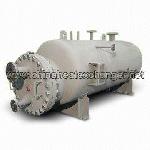
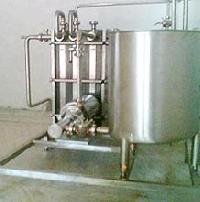
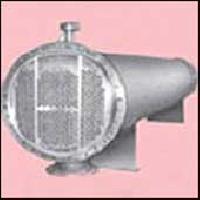
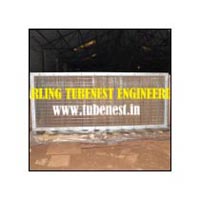

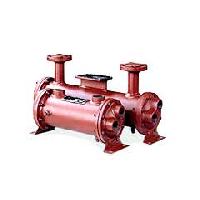
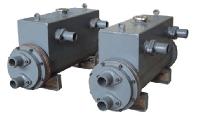
Marine Heat Exchanger
Get Price Quote
The Marine Heat Exchangers, which we offer, are available in the tubular form, or with an integral header tank, and models are available to suit engines of various outputs. This Marine Heat Exchanger is acclaimed for fast cooling of the marine engine. We are a dependable Manufacturer, Supplier and Exporter of Marine Heat Exchanger. Construction This Marine Heat Exchanger has a bundle of tubes, where two cooling circuits meet and exchange the heat. This bundle of tubes could be in the cooling circuit of an engine (Marine Heat Exchanger), the oil circuit (oil cooler) or intake air (inter cooler). There is a boat that we can supply with a heat exchanger to suit from the smallest petrol or diesel engine to large V8 petrol and medium-range diesels; Vertical Mounting with Integral Header Tank Horizontal mounting with Integral Header. We can manufacture the Tank of Marine Heat Exchanger, using modular construction from standard components. Design : As per ASME Section VIII Div. 1, TEMA RCB, IS 2825 & IS 4503. Capacity : As per Customer Requirements/standard Design Material of Construction : Size ranging from 3� to 100� in diameter & 40� (Feet) in length.

Marine Heat Exchanger
Get Price Quote
The exchangers are very high efficient and best product. High Quality design with high heat transfer ability. The advantages and problem areas with different heat exchanger types and materials are discussed. Marine heat exchanger is its size, cost and ease of adapting existing cold water systems to hot. Researchers, over the years, have used a variety of heat exchanger types and materials. The application of heat exchangers to large scale marine aquaculture.
Best Deals from Industrial Heat Exchanger
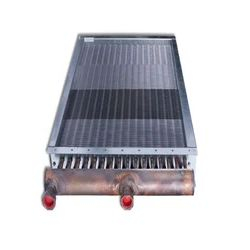
steam coil heat exchanger
75,000 Per Piece
1 Piece (MOQ)

Marine Heat Exchanger
Get Price Quote

Oil Coolers Heat Exchangers
Get Price Quote
Oil cooler are classified in to two. One is air cooled - oil cooler then water –cooled oil cooler. Air cooled oil coolers are mostly used where water availability is scarce and expensive. Water-cooled oil cooler, maintenance and operating cost are usually low. The cooled water manifolds, charges oil and air coolers for usage on marine engines. These heat exchangers are suitable for power steering, bow thrusters ,deck machinery etc. Application Oil Coolers are used for various applications involving cooling of Oils, Industrial Oil Coolers heat exchangers are widely used in refrigeration, power plants, air conditioning, processing of natural gas, chemical plants, petroleum refineries and petrochemical plants. Plastic Machinery Hydraulic Power Packs Marine oil cooler

Marine Heat Exchanger
Get Price Quote
Marine heat exchangers are the most common way to cool a boat's/ship engine, using the lake, river or Sea water in which the boat floats. Direct cooling of the cylinders and heads by sea-water is unsatisfactory because sea water will eventually ruin the cylinder block and heads. Since this water may be corrosive the engine may be cooled by a sealed mixture of distilled/Fresh water and antifreeze. Heat from the water-antifreeze mixture is then transferred to the Sea (or lake or river) water which flows into a heat exchanger. The water-antifreeze mixture runs through the heat exchanger dumping heat, but remaining separate from corrosive salts and chemicals found in the water the boat is floating in. If the Sea water eventually corrodes and ruins the heat exchanger it can be replaced at a fraction of the cost of replacing the engine.

Marine Heat Exchanger
Get Price Quote
Marine Heat Exchangers exhaust manifold is necessary on marine engines to reduce the temperature of the engine-room air space and the exhaust pipe. Our development is to combine a water jacketed exhaust manifold with the heat exchanger and header tank. This arrangement is particularly suitable for small series-produced engines; the manifold is cooled by fresh water and as a result a keel-cooled engine can be made by omitting the heat exchanger tube stack and the sea-water pump. On installation the fresh-water outlet from the manifold would be connected to the keel pipes and the return taken back to the engine fresh-water pump.

Marine Heat Exchanger
Get Price Quote
Marine Heat Exchanger, Mist Eliminators, Air Cooled Heat Exchanger

Oil Coolers Heat Exchangers
Get Price Quote
Gireesh offer a wide range of oil coolers in different designs. These are compact and sleek and have constant flat fin and tube heat exchangers. Perfect for economic cooling operations where there is shortage of water, these can be customized in terms of size and units as per the clients’ requirements. We provide a wide range of oil cooler which are mainly used in heat transfers of fluids, lubricating, transformer & high pressure circuits to cool items which are 100°c or higher. These tube oil coolers are present with following features. features: • oil has a higher boiling point than water, so it can be used to cool items 100°c or higher • used in heat transfers of fluids, lubricating, transformer & quenching oils • designed for high pressure circuits • oil is an electrical insulator, so it can be used inside of or in direct contact with electrical components • heat exchanger is a piece of equipment built for efficient heat transfer from one

Marine Heat Exchanger
Get Price Quote
Hitech Equipments range of heat exchanger are marine heat exchanger, industrial heat exchanger and heat exchanger that Marine Heat Exchangerswe present has been designed and developed in adherence with various international quality Marine Heat Exchangersstandards. These have a compact design and style of construction of the plate arrangement, which allows enhanced performance in Marine Heat Exchangers.

oil heat exchanger
Get Price Quote
Oil Coolers Heat Exchangers can be used to simulate the counter current flow of a single large exchanger.Oil Coolers choice of tube material could result in a leak through a tube between the shell and tube sides causing fluid cross-contamination and possibly loss of pressure.
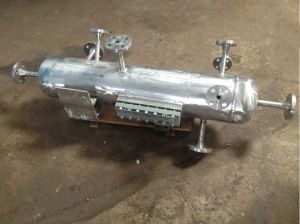
SS High Pressure Heat Exchangers
Get Price Quote
SS High Pressure Heat Exchanger is use of pipes or other containment vessels to heat or cool one fluid by transferring heat between it and another fluid. The walls of the pipe are usually made of metal. The exchanger consists of a coiled pipe containing one fluid that passes through a chamber containing another fluid. Another substance with a high thermal conductivity, to facilitate the interchange, The outer casing of the larger chamber is made of a plastic or coated with thermal insulation, to discourage heat from escaping from the exchanger. Specifications SS High Pressure Heat Exchangers are pressed to form troughs at right angles to the direction of flow of the liquid which runs through the channels in the heat exchanger. Applications : SS High Pressure Heat Exchangers are often spaced by rubber sealing and gaskets which are cemented into a section around the edge of the plates. Advantages : SS High Pressure Heat Exchangers are compressed together in a rigid frame to form an arrangement of parallel flow channels with alternating hot and cold fluids.

marine heat exchangers
Get Price Quote
We offer marine heat exchangers, Mercruiser heat exchangers, marine water pumps and other marine cooling systems parts. We only can assist you in determining the best all around product for your particular application. Marine heat system are the most common way to cool a boat's engine, using the lake, river or ocean water in which the boat floats. Since this water may be corrosive the engine may be cooled by a sealed mixture of distilled water and antifreeze. Heat from the water-antifreeze mixture is then transferred to the ocean (or lake or river) water which flows into a heat system. The water-antifreeze mixture runs through the heat exchanger dumping heat, but remaining separate from corrosive salts and chemicals found in the water the boat is floating in. If the ocean water eventually corrodes and ruins the heat system it can be replaced at a fraction of the cost of replacing the engine. To protect the marine heat exchanger from corrosive salts, a sacrificial zinc anode is screwed into the heat exchanger. This anode must be periodically replaced as part of regular maintenance. Because the water the boat floats in may be contaminated with floating particles such as wood or styrofoam balls the well designed boat will have a filter (often stainless steel mesh) to remove these particles before they are moved toward the heat exchanger. This filter must be periodically cleaned or else the flow of water to the heat exchanger will become obstructed and the engine will overheat. Ocean water is caused to flow through the heat exchanger by an impeller, often made of rubber and looking like a paddle wheel. Impellers commonly fail by having their paddles fall off and when this happens the engine will overheat unless promptly shut off. Many marine engines using heat exchangers have a grease reservoir for the impeller. In such cases a screw is often made part of the reservoir and is turned a small amount periodically, such as once a month, to apply a bit of grease to the rubber impeller to reduce friction and prolong its life. A consequence of using a heat exchanger on an in-hull marine engine is that there must be a thru-hull opening below the waterline to admit the ocean water to the marine heat exchanger. Most boats with this arrangement have a valve which closes this hole when the boat is unattended so that a leak in the cooling system will not cause the boat to fill with water and eventually sink. There are three methods employed for water-cooled marine petrol and diesel engines: direct, heat exchanger and keel cooling. Direct cooling of the cylinders and heads by seawater is unsatisfactory, because the engine – which was probably originally designed for radiator cooling – will run too cold and the sea-water will eventually ruin the cylinder block and heads. Our cooler is suitable for small boats operating in shallow weedy water, but the need for pipe work external to the hull is a severe limitation. Heat exchanger cooling is the most common method, the seawater being isolated in components which can be designed to withstand its corrosive affect. The closed fresh-water circuit can be thermostatically controlled so that the engine operates at its design temperature. Our heat exchangers are high-quality products incorporating both the best materials and the latest technical features. The tube stack is fully floating, thus minimizing thermal stresses, and it can easily be removed should cleaning be necessary. Our heat exchanger header tanks prevent aeration of the engine water circuit which must be designed so that the system is self-venting on initial filling.It is usual for all the components in the seawater circuit to be in series, the gearbox-oil and engine-oil coolers being on the suction side of the sea-water pump and the heat exchanger and any sea-water-cooled exhaust manifolds being on the discharge side. In the case of turbocharged engines the charge air cooler should receive the sea-water first so that the lowest possible air temperature is obtained. The sea-water outlet from the heat exchanger should be from the end cover equipped with the upper connection, this ensures that the tube stack is always full of water. The gearbox cooler size will depend on the type of transmission used, but it will usually be a size smaller than the engine-oil cooler. If preferred, the oil coolers can be fresh-water-cooled; these will need to be larger owing to the higher water temperature but need not be suitable for sea-water and can be taken from our leaflet ENGINE AND TRANSMISSION OIL COOLERS. A water-jacketed exhaust manifold is necessary on marine engines to reduce the temperature of the engine-room air space and the exhaust pipe. If the exhaust manifold is in the sea-water circuit it should be installed with the sea-water inlet at the back and the outlet at the front on the top to ensure that it operates completely full of sea-water. If the manifold is in the fresh-water circuit a small by-pass hole must be provided in the thermostat to ensure that some water is circulating through the manifold at ail times. Our development is to combine a water jacketed exhaust manifold with the heat exchanger and header tank. This arrangement is particularly suitable for small series-produced engines; the manifold is cooled by fresh water and as a result a keel-cooled engine can be made by omitting the heat exchanger tube stack and the sea-water pump. On installation the fresh-water outlet from the manifold would be connected to the keel pipes and the return taken back to the engine fresh-water pump. Heat exchanger/manifold assemblies are heavier than ordinary marine manifolds and must therefore be supported on the underside using the fixing lugs provided. When automotive engines are being converted for marine use the existing centrifugal-type pump should be retained for the fresh-water circuit and an additional pump fitted for the sea-water circuit. The sea water pipe bore should be chosen so that the velocity does not exceed 2 m/sec on the suction side and 3 m/sec on the discharge side of the pump. If the engine is being used to drive auxiliary equipment in a ship and the sea water supply is taken from the ship's main, ensure that the recommended flow rate cannot be exceeded.
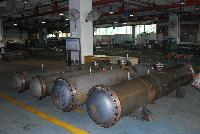
Industrial Heat Exchangers
Get Price Quote
Industrial Heat Exchangers, Air Cooled Heat Exchanger